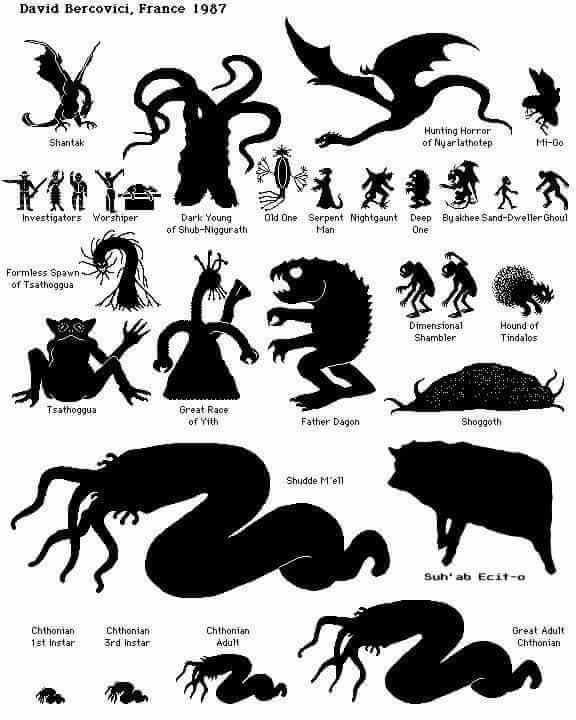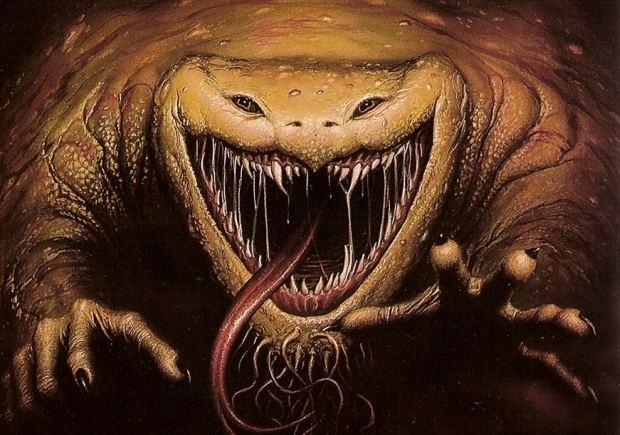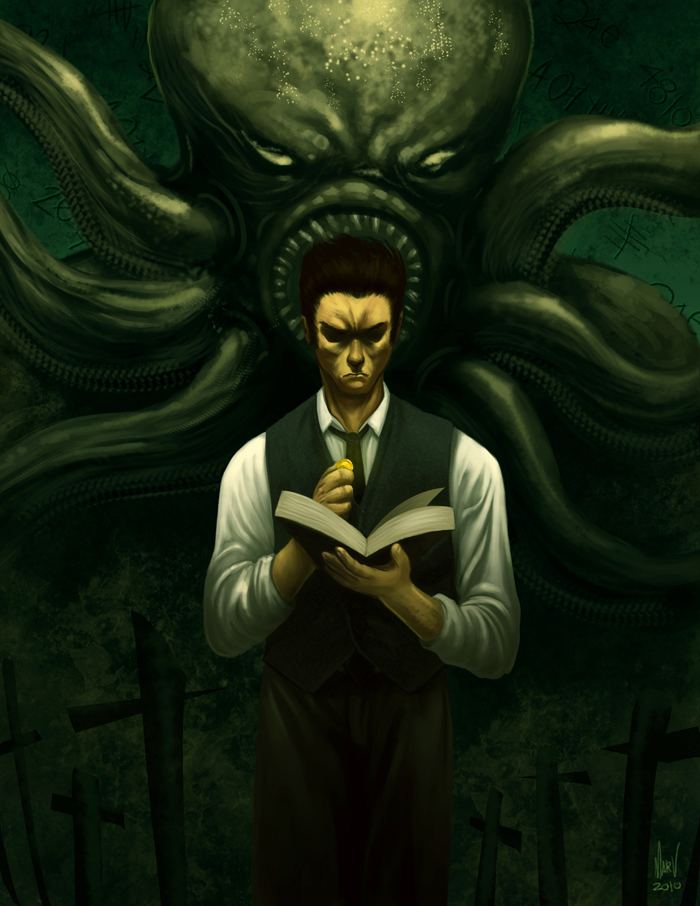 | ||
Exploring the cthulhu mythos cthulhu
The Cthulhu Mythos is a shared fictional universe, based on the work of American horror writer H. P. Lovecraft.
Contents

August Derleth, a contemporary correspondent of Lovecraft, first coined Cthulhu Mythos to identify the system of lore employed by Lovecraft and his literary successors. The name Cthulhu derives from a central creature in Lovecraft literature from the short story "The Call of Cthulhu" (which was first published in pulp magazine Weird Tales in 1928). The writer Richard L. Tierney later applied the term "Derleth Mythos" to distinguish between Lovecraft's works and Derleth's later stories.

Authors of Lovecraftian horror use elements of the Mythos in an ongoing expansion of the fictional universe.
History

In his essay "H. P. Lovecraft and the Cthulhu Mythos", Robert M. Price described two stages in the development of the Cthulhu Mythos. Price called the first stage the "Cthulhu Mythos proper." This stage was formulated during Lovecraft's lifetime and was subject to his guidance. The second stage was guided by August Derleth who, in addition to publishing Lovecraft's stories after his death, attempted to categorize and expand the Mythos.
First stage

An ongoing theme in Lovecraft's work is the complete irrelevance of mankind in the face of the cosmic horrors that apparently exist in the universe. Lovecraft made frequent reference to the "Great Old Ones": a loose pantheon of ancient, powerful deities from space who once ruled the Earth and who have since fallen into a deathlike sleep. This was first established in "The Call of Cthulhu", in which the minds of the human characters deteriorated when afforded a glimpse of what exists outside their perceived reality. Lovecraft emphasized the point by stating in the opening sentence of the story that "The most merciful thing in the world, I think, is the inability of the human mind to correlate all its contents."
Writer Dirk W. Mosig notes that Lovecraft was a "mechanistic materialist" who embraced the philosophy of cosmic indifferentism. Lovecraft believed in a purposeless, mechanical, and uncaring universe. Human beings, with their limited faculties, could never fully understand this universe, and the cognitive dissonance caused by limitation leads to insanity. Lovecraft's viewpoint made no allowance for religious belief which could not be supported scientifically, with the incomprehensible, cosmic forces of his tales having as little regard for humanity as humans have for insects.
There have been attempts at categorizing this fictional group of beings. Phillip A. Schreffler argues that by carefully scrutinizing Lovecraft's writings, a workable framework emerges that outlines the entire "pantheon" – from the unreachable "Outer Ones" (e.g. Azathoth, who apparently occupies the centre of the universe) and "Great Old Ones" (e.g. Cthulhu, imprisoned on Earth in the sunken city of R'lyeh) to the lesser castes (the lowly slave shoggoths and the Mi-go).
David E. Schultz, however, believes Lovecraft never meant to create a canonical Mythos but rather intended his imaginary pantheon to merely serve as a background element. Lovecraft himself humorously referred to his mythos as "Yog Sothothery" (Dirk W Mosig coincidentally suggested the term Yog-Sothoth Cycle of Myth be substituted for Cthulhu Mythos). At times, Lovecraft had to remind readers that his mythos creations were entirely fictional.
The view that there was no rigid structure is reinforced by S. T. Joshi, who stated "Lovecraft's imaginary cosmogony was never a static system but rather a sort of aesthetic construct that remained ever adaptable to its creator's developing personality and altering interests... [T]here was never a rigid system that might be posthumously appropriated... [T]he essence of the mythos lies not in a pantheon of imaginary deities nor in a cobwebby collection of forgotten tomes, but rather in a certain convincing cosmic attitude."
Price, however, believed that Lovecraft's writings could at least be divided into categories and identified three distinct themes: the "Dunsanian" (written in the vein of Lord Dunsany), "Arkham" (occurring in Lovecraft's fictionalized New England setting), and "Cthulhu" (the cosmic tales) cycles. Writer Will Murray noted that while Lovecraft often used his fictional pantheon in the stories he ghostwrote for other authors, he reserved Arkham and its environs exclusively for those tales he wrote under his own name.
Although not formalized and acknowledged as a mythos per se, Lovecraft did correspond with contemporary writers Clark Ashton Smith, Robert E. Howard, Robert Bloch, Frank Belknap Long, Henry Kuttner, and Fritz Leiber – a group referred to as the "Lovecraft Circle" – and shared story elements: Robert E. Howard's character Friedrich Von Junzt reads Lovecraft's Necronomicon in the short story "The Children of the Night" (1931), and in turn Lovecraft mentions Howard's Unaussprechlichen Kulten in the stories "Out of the Aeons" (1935) and "The Shadow Out of Time" (1936). Many of Howard's original unedited Conan stories also form part of the Cthulhu Mythos.
Second stage
Price's dichotomy dictates the second stage commenced with August Derleth. The principal difference between Lovecraft and Derleth being the latter's use of hope and that the Cthulhu mythos essentially represented a struggle between good and evil. Derleth is credited with creating the Elder Gods. He stated:
As Lovecraft conceived the deities or forces of his mythos, there were, initially, the Elder Gods... [T]hese Elder Gods were benign deities, representing the forces of good, and existed peacefully...very rarely stirring forth to intervene in the unceasing struggle between the powers of evil and the races of Earth. These powers of evil were variously known as the Great Old Ones or the Ancient Ones...
—August Derleth, "The Cthulhu Mythos"
Price suggests that the basis of Derleth's systematization is found in Lovecraft, stating: "Was Derleth's use of the rubric 'Elder Gods' so alien to Lovecraft's in At the Mountains of Madness? Perhaps not. In fact, this very story, along with some hints from 'The Shadow over Innsmouth', provides the key to the origin of the 'Derleth Mythos'. For in At the Mountains of Madness we find the history of a conflict between two interstellar races (among others): the Elder Ones and the Cthulhu-spawn." Derleth himself believed that Lovecraft wished for other authors to actively write about the myth-cycle as opposed to it being a discrete plot device. Derleth expanded the boundaries of the Mythos by including any passing reference to another author's story elements by Lovecraft as part of the genre: just as Lovecraft made passing reference to Clark Ashton Smith's Book of Eibon, Derleth in turn added Smith's Ubbo-Sathla to the Mythos.
Derleth also attempted to connect the deities of the Mythos to the four elements (air, earth, fire, and water), but was forced to adopt artistic license and create beings to represent certain elements (air and fire) to legitimize his system of classification. In applying the elemental theory to beings that function on a cosmic scale (e.g. Yog-Sothoth) some authors created a separate category termed aethyr.
"Lovecraft" mythos
A lesser known term employed by the scholar S. T. Joshi to describe the works of Lovecraft. Joshi identified four key elements in Lovecraft's mythos (that Price would later condense to three themes), being the fundamental principle of cosmicism (which once again highlighted the irrelevance of mankind), the imaginary New England setting, a pantheon of recurring "pseudomythological" entities and a collection of arcane books that supposedly yield insights into the mythology.
